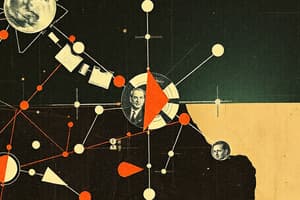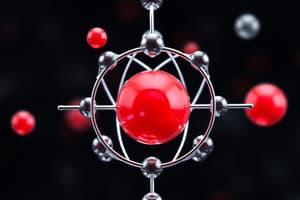Podcast
Questions and Answers
What particle is neutral and does not carry any charge?
What particle is neutral and does not carry any charge?
- Proton
- Electron
- Neutron (correct)
- Alpha particle
How is the atomic number of an element defined?
How is the atomic number of an element defined?
- The number of neutrons in the nucleus
- The total number of protons and neutrons
- The average mass of isotopes
- The number of protons in the nucleus (correct)
What does the mass number indicate about an atom?
What does the mass number indicate about an atom?
- Sum of protons and neutrons (correct)
- Average mass of isotopes
- Total number of protons only
- Total number of electrons
What fundamental force is responsible for binding protons and neutrons in the nucleus?
What fundamental force is responsible for binding protons and neutrons in the nucleus?
What occurs during nuclear fission?
What occurs during nuclear fission?
Which type of decay involves the emission of an electron or positron?
Which type of decay involves the emission of an electron or positron?
What describes the arrangement of electrons in an atom?
What describes the arrangement of electrons in an atom?
What is the most stable configuration of a nucleus?
What is the most stable configuration of a nucleus?
What factor can cause a nucleus to become unstable?
What factor can cause a nucleus to become unstable?
What describes isotopes of the same element?
What describes isotopes of the same element?
What does half-life represent in nuclear decay?
What does half-life represent in nuclear decay?
Which of the following best describes the role of electron energy levels in atoms?
Which of the following best describes the role of electron energy levels in atoms?
What is a limitation of the Bohr model of atomic structure?
What is a limitation of the Bohr model of atomic structure?
How do atomic properties like ionization energy affect chemical reactions?
How do atomic properties like ionization energy affect chemical reactions?
Which principle does quantum mechanics use to describe electron locations?
Which principle does quantum mechanics use to describe electron locations?
Which of the following applications is NOT associated with radioactive isotopes?
Which of the following applications is NOT associated with radioactive isotopes?
What do unique emission and absorption spectra allow scientists to do?
What do unique emission and absorption spectra allow scientists to do?
Which atomic model accounts for both wave-particle duality and accurately predicts atomic spectra?
Which atomic model accounts for both wave-particle duality and accurately predicts atomic spectra?
What is a fundamental characteristic of radioactive decay?
What is a fundamental characteristic of radioactive decay?
How do bonds form between atoms in a molecule?
How do bonds form between atoms in a molecule?
Flashcards
Atoms
Atoms
The fundamental building blocks of matter. They are composed of protons and neutrons in the nucleus, surrounded by electrons.
Nucleus
Nucleus
The positively charged center of an atom containing protons and neutrons.
Protons
Protons
Positively charged particles found in the nucleus.
Neutrons
Neutrons
Signup and view all the flashcards
Electrons
Electrons
Signup and view all the flashcards
Atomic number
Atomic number
Signup and view all the flashcards
Mass number
Mass number
Signup and view all the flashcards
Isotopes
Isotopes
Signup and view all the flashcards
Strong Nuclear Force
Strong Nuclear Force
Signup and view all the flashcards
Radioactivity
Radioactivity
Signup and view all the flashcards
Half-life
Half-life
Signup and view all the flashcards
Radioactive Decay
Radioactive Decay
Signup and view all the flashcards
Atomic Structure
Atomic Structure
Signup and view all the flashcards
Electron Energy Levels
Electron Energy Levels
Signup and view all the flashcards
Atomic Spectra
Atomic Spectra
Signup and view all the flashcards
Ionization Energy
Ionization Energy
Signup and view all the flashcards
Electron Affinity
Electron Affinity
Signup and view all the flashcards
Chemical Bonding
Chemical Bonding
Signup and view all the flashcards
Bohr Model
Bohr Model
Signup and view all the flashcards
Quantum Mechanics
Quantum Mechanics
Signup and view all the flashcards
Study Notes
Atoms
- Atoms are the fundamental building blocks of matter. They are composed of a nucleus containing protons and neutrons, surrounded by orbiting electrons.
- The nucleus is positively charged due to the presence of protons.
- Electrons are negatively charged, and their charge is equal in magnitude to the charge of a proton.
- Neutrons are neutral, carrying no charge.
- The number of protons in an atom's nucleus defines the element.
- The number of protons and neutrons in an atom's nucleus determines its mass number.
- Isotopes are atoms of the same element with different numbers of neutrons, thus different mass numbers.
- Atomic number (Z) is the number of protons in an atom.
- Mass number (A) is the sum of protons and neutrons.
- Atomic mass is the average mass of the naturally occurring isotopes of an element.
- Different elements have different atomic and mass structures due to unique quantities of protons, neutrons, and electrons.
- The arrangement of electrons in atoms is described by quantum numbers and energy levels. These levels are often visualized as electron shells.
- The electron configuration influences the chemical properties of atoms, explaining how atoms bond and react.
Nuclei
- The nucleus, the central part of an atom, contains protons and neutrons.
- The strong nuclear force binds protons and neutrons together in the nucleus.
- This force is short-range, acting only over distances comparable to the size of a nucleus.
- The electrostatic force between protons is repulsive.
- The strong nuclear force is much stronger than the electrostatic force at short distances.
- The stability of a nucleus is affected by the balance between the strong nuclear force and electrostatic forces.
- Nuclei with too many or too few neutrons relative to protons are unstable and undergo radioactivity.
- Nuclear reactions involve changes in the nucleus.
- Nuclear fission is a reaction where a heavy nucleus splits into two lighter nuclei, releasing large amounts of energy.
- Nuclear fusion is a reaction where two light nuclei combine to form a heavier nucleus, releasing energy.
- Radioactivity is the spontaneous emission of particles from an unstable nucleus.
- Types of radioactivity include alpha decay (emission of an alpha particle), beta decay (emission of a beta particle, either an electron or a positron), and gamma decay (emission of a gamma ray, a high-energy photon).
- Each type of decay has different properties, impacting the resulting daughter nuclei, the particles released, and the subsequent radiation energies.
- Half-life is the time it takes for half of the radioactive nuclei in a sample to decay.
- Understanding nuclear structure is crucial for applications like nuclear power, medical imaging, and radiocarbon dating.
- Radioactive isotopes have applications in medical treatments, like radiation therapy and diagnostic imaging.
Atomic Structure and Behavior
- The structure of the atom has a profound impact on its behavior.
- Electrons in various energy levels can transition between these energy levels.
- During transitions, energy is either absorbed or emitted in the form of photons.
- The characteristic energy levels of atoms lead to unique emission and absorption spectra.
- These spectra can be used to identify different elements.
- Atomic properties, such as ionization energy and electron affinity, are key factors in chemical reactions.
- Atoms bond with each other through sharing, gaining, or losing electrons. These bonds contribute to the formation of molecules and chemical compounds.
Models regarding Atomic Structure and nuclear behavior
- Various models have been proposed to explain atomic structure, each with limitations.
- The Bohr model, for example, pictures electrons orbiting the nucleus in specific energy levels. However, it's not accurate for more complex atoms.
- Quantum mechanics provides a more accurate description. Quantum mechanics details how probability is used to define electron locations, rather than specific orbits.
- Quantum mechanical models account for the wave-particle duality of electrons and predict atomic spectra with high accuracy. Similarly, models for nuclear behavior use quantum mechanical principles to explain the interactions and properties of protons and neutrons within the nucleus.
Studying That Suits You
Use AI to generate personalized quizzes and flashcards to suit your learning preferences.




